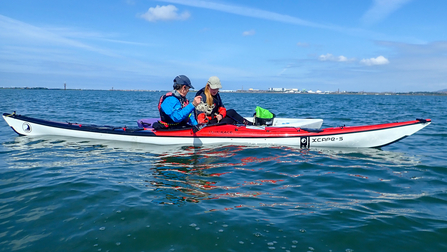As the
We're also able to facilitate volunteer input from the seven paddlesport clubs in Cumbria to the Trust's marine conservation events, such as beach and river clean-up.
Join by 30 January to get 3 months free membership!
Drone view of kayakers carrying out seagrass surveys in the Walney Channel, Cumbria. © Living Seas North West
As the
We're also able to facilitate volunteer input from the seven paddlesport clubs in Cumbria to the Trust's marine conservation events, such as beach and river clean-up.

© John Soady
It was an unusual but interesting request from the Trust's marine team to assist with a seagrass research project in the Walney Channel.
The aim was to identify species using the seagrass bed resources by placing underwater cameras and taking water samples above the beds for DNA analysis.
To assist, we recruited three sea kayakers from the Kendal-based Lakeland Canoe Club, setting off for the mission from Roa Island.

Carrying out a seagrass survey © John Soady
Each camera rig consisted of a GoPro camera attached to a steel grill with a small bag of mackerel as bait, and a float to mark its position (a camera rig is on the back deck of my orange kayak in the photo).
We had four camera rigs to place in GPS-tagged locations, with a drone monitoring our position, and then eight 5l water samples to collect from a different area of seagrass to avoid DNA contamination from the mackerel bait, and shuttle those back to a CWT shore team.
There are fast tidal streams in the channel and large areas that dry and flood suddenly, so it is important for safe working to understand the tides here.
Tides on the day were pretty perfect with high water around 10am, providing an estimated working time up to around midday before the water receded from the seagrass beds on the ebb.
It did indeed take until midday to complete the tasks and, as anticipated, getting a bit fraught later as the water disappeared from beneath us right on cue.
At this point the ebb stream was running fast in the main channel, which conveyed us back to Roa Island in double quick time.

Carrying out a seagrass survey © John Soady
Then out to Piel Island for lunch in the sun, a chat with Aaron Sanderson the current King of Piel (landlord at the island’s Ship Inn), and a walk round the castle ruins.
We rounded-off the day with a paddle over towards Walney South Reserve and a brief look at the grey seal colony (from more than 100m away - new seal protection guidance) and a ferryglide across the ebb stream brought us back to finish at Roa Island.